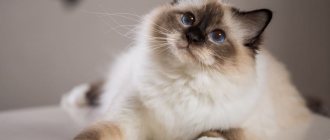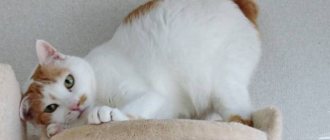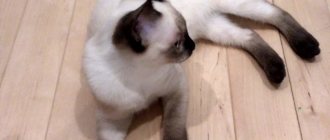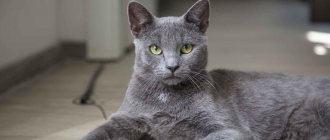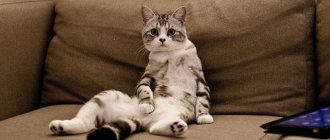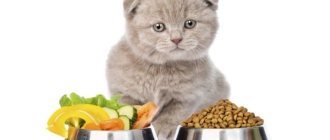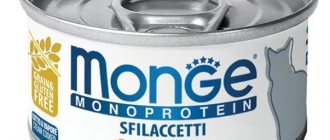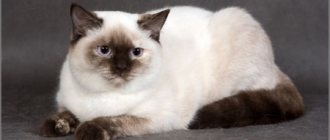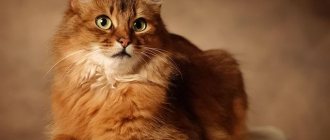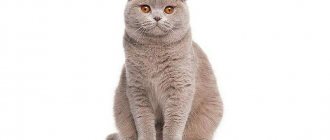The appearance of this cat immediately attracts attention - the “fatal” color combined with unusual honey-amber eyes. At first glance, this cute animal with a funny round face and plush fur seems affectionate and calm. In fact, they are active, inquisitive and friendly.
Let's find out how the black fold cat differs from representatives of other breeds and whether there are any peculiarities in its maintenance.
Description of the breed of Scottish black fold cats
The animal's head is round in shape, its forehead is flat, its ears are drooping. The coat is a solid black color. The average weight of an animal is about nine kilograms.
The ancestor of the Scottish Fold breed was the cat Susie. Which was born in a litter of a semi-wild cat, the father was unknown. For a long time, Susie caught mice and lived in a modest closet. Very soon the cat began to give birth. Mary Ross adopted one of these kittens.
Later, it was this lady, with the help of eminent breeders, who would develop the main algorithm for the birth of fold-eared kittens.
Now the Scottish Fold breed has become extremely popular all over the world. Many of our compatriots also liked kittens with fancy ears.
Currently, the Scottish Fold breed is extremely popular
Character of black Scottish cats
The character of black Scottish cats can be different, it does not depend on the color. There is evidence based on a survey of owners that black cats are active, stress-resistant, phlegmatic, intelligent, friendly and stubborn. Rumor also attributes to them good ability to catch mice. However, from a scientific point of view, owner surveys alone are not sufficient to draw such conclusions. After all, the answers are very subjective.
It has not yet been scientifically proven that genes for black color are linked to genes for any character traits. And such a quality as the ability to catch mice is generally determined not by color, but by whether the mother cat taught this craft to her babies in childhood. If you want to learn more about this, check out the separate page on the site.
Article continues after advertisement
One of the color variations is black smoke
As for the vaunted tolerance and reduced aggressiveness of black cats, scientists have already proven that this quality is directly related to the size of the adrenal glands. Thus, modern domestic cats have smaller adrenal glands than their wild ancestors, so they are less aggressive. Thus, black cats, if they were less aggressive, should have smaller adrenal glands than the average domestic cat. But their adrenal glands are no different. Thus, reduced aggression is a myth. But black cats do not have increased aggressiveness: there are different individuals among them.
Let us repeat once again: there have been no reliable studies proving the connection of the color gene with the gene of any character traits in cats.
Maintenance and care
Many breeders of black fold cats agree that their pets are very unpretentious in their maintenance. In addition, they are one of the few cats that like to take water treatments. But still, you shouldn’t bathe them often. It's better to do it only when absolutely necessary.
Pets' fur also requires care. In order to prevent the animal from shedding, it is recommended to brush it regularly with a massage brush. Soon the pet will get used to this daily procedure and even begin to enjoy it.
A bed or house for a Scotsman must be equipped away from the passage, in a remote and quiet corner of the room. It is better to choose a tall scratching post, as cats of this breed love to stretch out on it. To carefully care for your animal’s nails, you can purchase special scissors and use them to treat the paws at least 2 times a week.
Diseases and health problems
Due to the fact that this breed was created by nature due to a genetic mutation, Scottish Folds may suffer from genetic diseases such as osteochondropathy. This is a hereditary congenital disease that can be fatal to the animal.
These cats may also suffer from other congenital diseases such as arthritis, chondrodystrophy, arthrosis. These diseases are most often the cause of incorrect crossing of lop-eared and straight-eared pets. Therefore, when buying a kitten, you need to pay special attention to the kitten’s movements, gait, and tail movement.
Due to the unusual shape of the eyes, Scots often suffer from entropion, and the animal requires surgical intervention. Older cats may develop cataracts or glaucoma.
Important fact: Some cats may be allergic to certain types of food, so if you notice that your cat is itching and acting strange, it is best to take the animal to the vet.
Older cats may suffer from diseases of the cardiovascular system, stomach and liver problems may occur, so once a year the animal must be shown to a veterinarian. Through contact with other animals, a cat can also become infected with various parasitic diseases. Therefore, it is always necessary to take preventive measures and avoid contact with carriers of parasites.
Pet character
Representatives of this breed have a special love for children and the elderly. Having found their pet, cats follow on its heels and never tire of showing affection at the first favorable moment. The voice of this breed is not similar to the usual meow, it is rougher and harsher.
Black fold cats are very easy to train. It is not particularly difficult to teach an animal to go to the litter box or even teach a few unusual tricks.
These purring lumps easily get along with other pets: dogs, turtles, birds and fish.
Black fold-eared cats are easy to train and can even follow simple commands.
The only disadvantage of the breed is that they do not like other cats and, at first, can be hostile towards new residents. But, after some time, hatred gives way to love, and the black fold-eared cat becomes a faithful ally to his new feline friend.
Character and habits of Scottish Fold cats
Scottish Folds are simply created for life in a large family. They are very sociable and playful. They love to involve all family members in their games. Scottish cats are very sociable and get along well with children and the elderly. They allow children to cuddle themselves and play with them with pleasure. As for the character of each individual, like people, it is individual; some associate the color of an animal with certain character traits.
For example, it is believed that blue Scots, due to their British genes, have a more quarrelsome character, and on the contrary, bicolors are considered cats with a soft and good-natured character. However, each animal is individual in one way or another. Some Scots do not leave the hands of the owner and strive to be close to the owner, while others, on the contrary, do not let anyone near them.
Interesting fact: Handsome adult lop-eared cats can easily tolerate loneliness and can sleep all day or occupy themselves on their own. However, if the animal wants attention or gets hungry, it will definitely let you know about it with its loud “meow”.
The Scots also have such character traits as stubbornness and willfulness. Often expressed in whims and a desire to be the center of attention. Although these cats can be trained well. At the genetic level, cats of this breed have certain beautiful manners. The Scots are well accustomed to the litter box, they recognize the scratching post and do not damage the furniture; they behave quite decently and decently.
Even if the cat is offended by something, he will not take revenge. The Scots never steal food, they can eat from the table or from the pots, but they never hide, but eat calmly and openly, with the dignity of kings.
How to choose a kitten
Basically, the price consists of the external characteristics of the kitten, its health, the presence of a veterinary record and documents. Pricing is also influenced by the status of the parents, the number of their exhibitions and medals won.
It is also worth paying attention to the age of the kitten. No self-respecting breeder will sell you an animal that has not reached 3 months of age. It is at this time that the kitten’s final color has already formed and mandatory vaccinations must be given.
The average cost of a kitten of this breed is about 20,000 rubles. Most lovers of this breed prefer nurseries over ordinary breeders, since getting a kitten with problems tends to zero.
You can purchase an already sterilized kitten after at least 6 months from its birth. The cost of such a pet will be much higher.
History of the breed
The breed standard was officially registered in 1993 and is today recognized by most influential organizations. The history of selection of fold-eared long-haired cats began much earlier, in the 60s of the 20th century.
One day, the most ordinary cat gave birth to offspring, in which one of the cats turned out to have funny, floppy ears and long white hair. This happened in an area of Scotland called the Highlands, which gave the name to the breed.
At first, lop ears were considered a sign of marriage, but then such cats began to be specially bred.
It is believed that the gene for folding ears was inherited from Scottish cats from Persian ancestors. The fact is that Persians were crossed with the British in order to improve and consolidate the breed characteristics of the latter. British cats, in turn, were involved in the breeding of the Scottish Fold, the “big brother” of the Highland Fold.
Health
The main thing that owners should do is to monitor the condition of the animal and vaccinate on time. The first vaccination is given to kittens at the age of two months, then every year (complex vaccination against hepatitis, rabies, plague and other viral pathogens).
The weak points of these fluffies are their ears and eyes. It is necessary to monitor their hygiene and cleanliness daily. Also, you should not expose your cat to drafts; bronchitis is a disease that can affect not only humans, but also animals.
In general, black fold cats have good health and excellent appetite.
An unpretentious, but at the same time kind and intelligent black fold cat can become a good friend for its owners and give many pleasant moments. Created specifically for the home, it brings comfort and tranquility to it. The black color gives the breed status and luxury, which will be appreciated at all world exhibitions.
Character
Just because your pet doesn't run to the door to greet you doesn't mean he's not attached to you. It's just that the British understanding of love and friendship is somewhat different from the affection and loyalty of dogs. They seem to be on their own, but at the same time they desperately need your attention and care. The lop-eared dog will not impose itself, but if you notice that it has perched itself next to you, do not be lazy and pet it. He will be endlessly pleased.
These cats are completely non-aggressive , but they will stand up for themselves without hesitation. They are patient with children, but their patience has narrow limits. Therefore, you should not persistently squeeze or invade the animal’s personal space. You are not purchasing a toy for your child, but a living being with its own character, ambitions and desires.
The Briton gets along easily with other cats , although he will try to take a dominant position, and if he doesn’t succeed, he will simply act independently and aloof. With dogs, they can behave aggressively and hit the cheeks if they feel that they are being harassed or try to attack.
The furry nature of lop-eared animals is aimed at the instinctive desire to protect themselves. If the animal feels completely safe, feels love and at the same time the boundaries of what is permitted, then you will not be overjoyed to have this sweetest creature in your home. He will only delight and amuse you .
Caring for Scottish Folds
A Scottish cat should be combed using a special device - a furminator. The device will remove dead hair and give the animal an attractive appearance. You can also comb your pet’s fur with a special brush; it is enough to use it several times a week. Such care procedures prevent the animal's fur from becoming tangled and the formation of hairballs in the stomach. If necessary, purchase pastes to remove lumps. You should bathe your Scottish Fold no more than once every 1-2 months using shampoo.
Daily care includes hygiene procedures: moisten a swab or napkin with clean water, wipe the animal’s eyes and nose. Clean your cat's ears with cotton swabs once a week. Brushing your teeth daily or several times a week using a paste with meat scents and a brush. Natural feeding cats need this.
Colors of Scottish Straight cats
There is no difference in coat color variations between Scottish Straights and Folds. Cats with straight ears come in exactly the same colors as their fold-eared relatives:
- plain;
- bicolor;
- point;
- tipping;
- tabby
Similarly with the long-haired “Scots” (Highland Fold and Highland Straight), they are also characterized by all of the listed colors.
INTERESTING! As Scottish kittens grow, the color of their coat gradually changes. The final color is formed when the animal reaches 2 years of age.
The most popular are smoky, chinchilla, single-color, tortoiseshell, and shaded representatives of the straight-eared Scottish variety.
Feeding and types of food for your pet
Small kittens from two to four months eat up to six times a day. The kitten will mature and in the period of 4-6 months feeding is reduced to four times. At the age of 6-8 months, Scottish cats eat three to four times a day. Closer to a year, the pet switches to two meals a day, morning and evening. The water for your pet is regularly changed to clean water at least once a day.
The diet of Scottish Folds is divided into natural, industrial, or mixed. Each diet has positive and negative aspects:
- Natural food that the owner prepares specifically for the pet. The meat used is low-fat varieties, mainly chicken, rabbit, and veal. The meat can be boiled or given raw. The product should be finely chopped and slightly warmed. As a rule, meat products are mixed with boiled or raw vegetables. Cabbage, zucchini, pumpkin, and carrots are suitable for cats. You can also mix the meat with bran or porridges made from buckwheat, oatmeal, or rice. Meat is sometimes replaced with liver, heart, and stomachs. To do this, boil and chop, then mix with vegetables and porridge. You can lightly season the dish for your pet with sunflower, olive, and linseed oils. Greens are necessary in the animal’s diet; you can give parsley and lettuce. Fish products are given no more than twice a week. For a Scot, fish is chosen only from the sea, boiled and finely chopped, and removed from the bones. Every day you can give fermented milk products, choosing low-fat varieties of yogurt, cottage cheese, fermented baked milk, and kefir. It is better not to use sour cream, cream or milk in your pet’s diet. It is useful to give vitamins in the autumn and spring seasons, which will make up for the lack of minerals and amino acids. Vitamins are prescribed by a veterinarian.
- Industrial food is divided into dry ready-made food and wet food. This option significantly saves time for the owner; you only need to open the jar before eating. It is recommended to be interested in the composition before purchasing. A small amount or complete absence of meat in the product, as well as the presence of animal, vegetable fats and grains, is possible with cheap and low-quality production. Such nutrition will negatively affect the health of the animal. It is better to choose food marked premium or extra class.
- A mixed diet for a cat consists of alternating industrial food with natural food. For example, feed a Scotsman with prepared food in the morning, and prepare natural food in the evening. Many owners have a negative attitude towards mixed feeding; they believe that the combination leads to difficult digestion for the pet.
Scottish Folds love cleanliness; food should only be given in clean bowls and fresh. Overfeeding an animal leads to excess weight, heart and vascular diseases, and disorders of the musculoskeletal system. Ready-made food for Scottish fold cats should be used in accordance with the age of the pet.
Nutrition
Fold-eared cats are unpretentious to food, but you still shouldn’t feed them leftover food from your table. The ideal food for this breed is premium dry food. It is best to purchase such food in specialized stores or veterinary pharmacies.
If the owners do not have the opportunity to buy expensive food for their pets, then you can prepare food for them yourself. It is better to take poultry or lean beef as a basis and give it in the form of minced meat. Buckwheat, rice or oatmeal porridge is best as a side dish.
If you prepare your pet’s food yourself, do not forget to add vitamin and mineral complexes with a high calcium content to the diet.
Scots are unpretentious in food, but all cats of this breed require additional vitamins
The kitten’s diet is different in that it should be fed at least 5-6 times a day in small portions. If the baby’s diet consists of special food, then it is best to choose a liquid option in the form of jelly with pieces of meat or pate. There should always be water in the bowl and change every day.
Breed Features
Scots have straight ears from birth, which acquire their final shape by the time the kitten is three months old. This breed is often confused with the British, but its representatives are characterized by their own characteristics. Unlike the former, Fold-eared Scots are characterized by an even character, affectionateness and complaisance. British cats, on the contrary, are independent and arrogant. In addition, handsome fold-eared cats are very smart and easy to train; they never scratch furniture, tear curtains or break vases.
Scottish Folds are in excellent health and can live up to 15 years with proper care. The cats' legs and neck are short and powerful, and they have well-developed muscles. Unlike other cat breeds, Scots have triangular small ears that are pressed tightly to the skull, their tips pointing slightly downward due to the specific structure of the cartilage.
These pets have a luxurious coat; its color can be different, from snow-white, black, cream, blue to marble, smoky and silver shades.
Before you bring a Scottish Fold baby into your home, you need to be prepared for the fact that he will require a lot of attention to his person. The baby should not only receive good nutrition and care, but also have constant communication with the owners. The main feature of this breed is considered to be the inability to meow; instead, representatives of the feline species make sounds that resemble squeaking. In addition, these cats can move and sit only on their hind legs and love to sleep on their backs.
These cats have a thickening in the whisker area, which makes the animal seem to be constantly smiling.
Features of color
Ancient cats had several color options. Felinologists associate this phenomenon with the natural need to camouflage during hunting. Later, when animals became domesticated and began to live next to humans, the number of color combinations increased due to interbreeding.
Eumelanin, a high-molecular pigment with a complex chemical formula and irregular structure, is responsible for the formation of the charcoal shade. As part of cat hair, it is represented by spherical granules that absorb the color spectrum as much as possible. They are evenly located along the entire length of the hair and color it from the root bulb to the very tip.
It is very difficult to get a beautiful black color in fold-eared cats. The color is traditionally “capricious” and often takes on extraneous shades. This is especially true for animals with thick undercoat. It becomes covered with reddish “rust” or piebald gray hair, which noticeably detracts from the spectacular appearance of the black coat.
Another problem in obtaining a pure black color in fold-eared cats is the presence of additional derivatives of the eumelanin pigment: brown and cinnamon (cinnamon). If the selection of partners for mating is incorrect, these shades affect the process of color formation.
In natural breeds, brown color is extremely rare, but Scots do not belong to the group of aboriginal cats and therefore have a very high risk of such a transformation.
But in its pure form, black eumelanin provides some benefits for a cat's appearance:
- The wool gains mechanical strength - the pigment strengthens the hair.
- Chemical treatment does not affect eumelanin; it is resistant to aggressive environmental influences and is not dissolved by organic compounds.
This is interesting! In England, black cats are not viewed with suspicion. They are believed to bring good luck to the home and even help women in love.
Genetics of black color
If, on the part of pigments, only one element (eumelanin) affects the color of black Scottish fold cats, then several components take part in genetic engineering.
- The main dominant gene for black color is B. In various combinations of alleles, it can turn into bb (chocolate color) or b1b1 (cinnamon color).
- The agouti gene in the dominant state A forms the pattern on the coat, and in the recessive state aa gives a solid color. For a black or black and white fold cat, this item usually takes the recessive form aa. Although the pattern is not visible on the main color, the white areas are characterized by a complete absence of pigment and also do not react to agouti. But for brown and cinnamon animals, gene A is very important.
- Tabby (T) is a pattern on the coat; it can take the form of stripes, spots, and ripples. Totally depends on the agouti.
- Gene D. In the dominant state, the color remains unchanged, and in the recessive state, dd lightens it by several tones. For example, in a Scottish fold black and white cat, the main color will be replaced by blue.
The genetic formula for the ideal solid black color in the Scots is expressed as follows -aaB-D- (no agouti/black/no bleaching).
Additional genetic “components” take part in the formation of bicolors (a combination of the main color and white).
- Option Ss – bicolor. Under normal conditions, the proportion of colors is approximately 30:70.
- Sisi combination – white spots (buttons, medallions).
- Van color – Sw. In this black and white version, the Scottish Fold cat is colored dark on the tail and in the ear area, while the rest of the coat remains light.
Eye color
The influence of coat color genes on eye color has not yet been established. Scientists believe that so-called polygenes complicate matters here. They give instructions simultaneously to several hereditary characteristics, both hidden and obvious. Eye color in cats falls precisely into this section.
The animal does not have any separate genetic instructions from the parental set of chromosomes, but from generation to generation it duplicates the same characteristics.
Black Scottish Fold cats traditionally have copper or honey-amber irises. Green color is also allowed in native breeds, but Scots do not belong to this group.
Important! The color of the nose and paw pads depends on the shade of the coat. For black Scottish Folds, they should be the main color.
What to do before the appearance of the Scottish fold?
Scottish Folds are usually ready for independent life at 2-3 months of life, it is at this time that they are weaned from their mother, but before you get this kitten, you need to carefully prepare everything.
- First of all, you should purchase dishes from which the baby will eat and drink. It is best to give preference to bowls made of stainless steel or porcelain; a container made of food-grade plastic may also be suitable. Additionally, you will need to buy toys, a house and a tray with filling. Since the kitten will need to be shown to the veterinarian periodically, it is necessary to buy a spacious carrier; it will also come in handy during trips to the country.
- The next stage of preparation will be drawing up a daily routine and selecting a balanced diet. At first, it is not recommended to give dry food to the little handsome guy.
- The final step will be preparing the site for the house. It should be protected from drafts and not noisy, so that the pet can rest comfortably (Scottish Folds are large sleepyheads). When the animal gets used to its new habitat, it will gradually begin to explore the entire space of the room. During this period, the baby needs to be given maximum attention and given affection.
Description of appearance
The breed standards correspond to those of the Scottish Fold. In appearance, these cats resemble cute soft toys: they have fluffy, “cloudy” fur, so they look like slightly plump balls.
Varieties of Scots
However, the body of the Highland Fold is usually of medium size, fairly proportional, with well-developed muscles. Some individuals reach a weight of 8 kg, but usually they are small, about 4-5 kg. The legs are strong, not very long, the paws are rounded, and fur grows between the toes. The tail is very fluffy, should be straight and mobile, wide at the base, tapering to the tip. The length of the tail is ideally two-thirds the length of the cat's body.
A characteristic feature of the Highland Fold is its downturned, hanging ears. They can have from one to three folds.
The breed is distinguished by a large number of acceptable color varieties: cats can be one-color, two-color, any patterns or stripes on the coat are acceptable.
Highland Folds come in the following colors:
- monochromatic - the same shade evenly distributed throughout the body: blue, gray, red, chocolate, black, lilac;
- tortoiseshell – two colors evenly distributed over the body: red and black;
- bicolor or two-color - the cat is painted in two colors, the combinations can be very diverse;
- smoky (smoke) - the pigment is unevenly distributed along the length of the hair: at the base it is colorless, and at the tip it is black, this pigmentation of the coat creates an unusual and beautiful smoky color;
- color point - the whole body is covered with white hair, and on the nose, muzzle, ears, lower parts of the legs and tail the color is contrasting, darker;
- tabby (wild color) - the coat is colored in uniform stripes alternating lighter and darker shades, on the muzzle dark lines form the letter “M” on the forehead and around the eyes, giving them exceptional expressiveness (tabbies can be marbled, spotted, ticked);
- Calico is a combination of three colors: black, white and red, sometimes called “tortoiseshell and white.”
